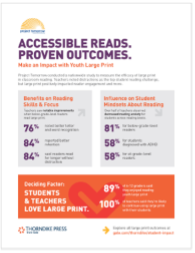
|

|
Iowa Gives Every G1 Student Decodable Books
Gov. Kim Reynolds and the Iowa Department of Education have announced a statewide investment of over $3.5 million to provide every first grade student with decodable book packs to take home and keep, reinforcing classroom instruction.
“Iowa is making early literacy a top priority, recently enacting landmark literacy legislation, improving state standards and ensuring teachers have the tools they need to hone this foundational skill in their students,” Gov. Reynolds said. “These book packs, based on the Science of Reading, bring parents more fully into that process by giving them a fun way to reinforce at home what their children are learning at school. It’s a powerful way to teach our kids to read—so they can spend a lifetime reading to learn.”
“In partnership with their classroom teachers, families across Iowa can use these evidence-based book packs to reinforce phonics and decoding skills with their children anytime, anywhere,” said Iowa Department of Education Director McKenzie Snow. “These decodable books meet students where they are, supporting reading comprehension that unlocks a child’s lifetime of potential.”
The book packs are being provided to all public and accredited nonpublic elementary schools to give to nearly 38,000 first-grade students. Kindergarten through second grade students in need of support who attended a Department-funded high-quality summer reading program or a Learning Beyond the Bell out-of-school program this year will also receive decodable book packs to further advance their reading gains.
In total, more than 100,000 book packs will be sent to all public and accredited nonpublic schools across the state this winter. Schools and families do not need to apply—the book packs will be sent directly to them. One million books will be sent in total as part of the book packs.
Funds for these Science of Reading-aligned book packs are provided through the Iowa Department of Education’s portion from the American Rescue Plan Elementary and Secondary School Emergency Relief (ARP ESSER) Fund and the American Rescue Plan Emergency Assistance to Nonpublic Schools (ARP EANS) Fund to address state-level educational efforts.
Michigan Implements New Literacy/Dyslexia Bills
Two new literacy/dyslexia laws were signed last month by Michigan Gov. Gretchen Whitmer at Gardner International Magnet School in Lansing.
“Kids won today,” said State Superintendent Dr. Michael F. Rice. “This is the most consequential education legislation signed in Michigan in the past two decades, with the possible exception of historic state school aid budgets for fiscal years 2023 and 2024. In the coming years, Michigan children learning to read will benefit enormously.”
In September, the state Senate and House sent two literacy/dyslexia bills to the governor in resounding bipartisan votes. The K-12 literacy/dyslexia legislation that now becomes law has been championed by the Michigan Department of Education (MDE) and the State Board of Education. Senate Bills 567 and 568 become law. The legislature had been working on various iterations of the bills for over five years.
“It’s encouraging to witness Gov. Whitmer and our partners in the Michigan Legislature joining together — across the aisle — to take action to ensure that Michigan children have the necessary tools to develop their reading skills,” said Board President Dr. Pamela Pugh. “They recognize that literacy is a fundamental component of educational success. This investment in education benefits not only individual students but also fortifies communities and the state as a whole.”
MDE officials testified in support of the bills before the Senate Education Committee in February. They testified before the House Education Committee in June to encourage legislators to pass the bills.
Improving early literacy achievement is one of the goals in Michigan’s Top 10 Strategic Education Plan. The law will strengthen the effectiveness of literacy instruction and intervention for Michigan students, MDE officials say. It will also provide for both pre-service and in-service training to educators to learn or strengthen skills needed to identify Michigan students with characteristics of dyslexia.
“We at MDE recognize our role and responsibilities in implementing these new laws for the benefit of children. Now that the bills have been signed into law, we look forward to working closely with our partners, including local school districts, intermediate school districts, and institutions of higher education,” said Dr. Sue C. Carnell, MDE chief deputy superintendent.
Beginning in the 2027-28 school year, the new laws will require public schools to:
- Screen, with a tool from a list of approved screening tools, all students in kindergarten through third grade for characteristics of dyslexia three times per school year.
- Ensure that reading intervention is provided to all K-12 students who demonstrate characteristics of dyslexia as a result of screening assessment data.
- Use a Multi-Tiered System of Supports (MTSS) framework to organize evidence-based classroom and intervention instruction and materials to effectively meet the needs of all learners.
- Provide literacy consultants, teachers, literacy coaches, and other instructional staff with professional learning on characteristics of dyslexia, instructional practices, and accommodations that have strong evidence for improving literacy outcomes and are consistent with the Science of Reading.
- Select from a list of approved reading instructional materials.
MDE will provide guidance and support for required pre-service and in-service learning and implementation strategies to public schools and institutions of higher education. Currently, Language Essentials for Teachers of Reading and Spelling training, commonly known as LETRS, is professional learning that is accessible to Michigan elementary teachers and administrators and that is aligned to the new laws. MDE has strongly recommended this training for elementary teachers across the state. Approximately 2,600 Michigan teachers have completed the training and another approximately 7,500 have begun the training.
PA Reading Curricula Bill Passes
Pennsylvania may soon have a list of reading curricula designated by the state as “evidence-based,” under a bill that unanimously passed the House and Senate.
Unlike an earlier version of the legislation, the bill expected to be signed by Gov. Josh Shapiro won’t force any school districts to use the curricula or change how they teach reading . Science of Reading advocates say they’re still pushing to require schools to use the approved curricula and screen all young students for reading difficulties, but called the bill an important first step.
The bill directs the state Department of Education to select a council of 20 members with expertise in structured literacy to produce a list of approved evidence-based reading curricula, “aligned with the Commonwealth’s academic standards and the science of reading.”
It will also produce a list of approved structured literacy trainings for teachers, screening tests to assess children’s reading needs, and intervention approaches for children deemed in need of additional reading support.
The council must include public school elementary teachers — including reading specialists, literacy coaches, and special education teachers — and represent urban, rural, and suburban school districts.
The bill sets a deadline of June 1, 2025, for the education department to develop the list of approved reading curricula and other materials.
Literacy Funding Withheld in Wisconsin
Wisconsin State Superintendent Dr. Jill Underly is calling on lawmakers to release nearly $50 million to fund a new school literacy program.
Last year Wisconsin Act 20 passed with bipartisan support. The aim of the act is to increase reading proficiency in third graders by addressing curriculums and identifying struggling students in earlier grade levels.
The act calls for the hiring of literacy coaches to improve reading scores, but the agency has lacked the funding to bring on the staff.
Underly sent a letter to the Republican leaders of the Legislature’s Joint Finance Committee, telling them the money is needed. “Now is the time to keep your promise to Wisconsin families,” she wrote. “Now is the time to take action and release the funding.”
New Jersey
Last month, New Jersey Gov. Phil Murphy signed two bills into law to establish initiatives intended to improve young learners’ access to tools and resources to help them become better readers while providing educators with professional development opportunities.
The New Jersey School Boards Association supported both measures while advocating for the necessary funding and resources to ease implementation of the provisions of each bill.
Dr. Timothy J. Purnell, executive director and CEO of the NJSBA, applauded the signing of the bills, stating. “Literacy is the essential skill that serves as the foundation for all learning. The New Jersey School Boards Association thanks Governor Murphy for prioritizing this issue and Senate Majority Leader Ruiz for her leadership in spearheading these critical measures that demonstrate her commitment to the children of New Jersey.” He added, “And we applaud the entire Legislature for taking swift and bipartisan action in promoting and approving these bills, which will better prepare New Jersey’s students to become lifelong learners and productive citizens. We look forward to seeing the positive impact they will have on students’ academic achievement.”
The first bill (S2644/A4303) aims to strengthen foundational literacy instruction by establishing a Working Group on Student Literacy. This group, comprised of members appointed by the commissioner of education from all regions of the state, will make recommendations to the New Jersey Department of Education on the implementation of evidence-based literacy strategies, screening methods, and instruction for students, in addition to investigating ways to expand professional learning.
Based on these recommendations, the NJDOE will develop and publish guidance for school districts to use beginning with the 2025-2026 school year and shall establish an online resource center to aid school districts in the selection of evidence-based, high-quality literacy instructional materials, including data analysis tools, as part of the school district’s implementation of the New Jersey Student Learning Standards in English Language Arts. Additionally, the NJDOE will create a professional development program for early education teaching staff, including librarians, and those serving multilingual learners and/or students with disabilities. This will be available to all districts at no cost.
Under the bill, districts will be required to conduct literacy screenings at least twice annually for students in grades K-3, beginning in the 2025-2026 school year. Districts must notify parents and guardians of their child’s results within 30 days of the close of the initial screening period. The fiscal year 2025 budget includes $5.25 million for literacy initiatives to advance this work.
The second bill (A2288/S2647) establishes the Office of Learning Equity and Academic Recovery in the Department of Education to promote student literacy and advance learning equity through academic recovery practices.
The office will be responsible for improving the Department’s capacity to make data-driven decisions, coordinate resources, and research best practices to support the creation of effective literacy, learning equity, learning acceleration policies, and professional development opportunities.
“Literacy education represents the foundation upon which all future learning is built, and we owe it to our children to give them the strongest foundation possible,” Murphy said. “By bolstering support for literacy education, we are enabling New Jersey students to thrive both academically and in life, helping them to become informed, thoughtful, and engaged citizens.”
Assembly Speaker Craig J. Coughlin said, “Increased equity in education, especially for foundational literacy, will serve every community in New Jersey. When every child in our state has a greater opportunity to succeed, we all benefit. These laws will ensure more strategic use of resources for our best-in-the-nation public schools. I want to commend my colleagues for all of their work on this legislation, partnering with teachers and other experts and advocates in the field to deliver for New Jersey’s kids.”
Maryland
The Maryland State Superintendent of Schools is proposing a new policy that would hold 3rd graders back if they do not meet reading requirements. The proposed retention policy, already in place in more than half of US states, prompted concern from many educational experts and officials.
DeMyra Harvey-Morris, a former educator and the Project Read Coordinator for the Wicomico County Public Library, says it could disproportionately impact disadvantaged students. “There’s about 1 million people in Maryland right now, who can’t read above a 3rd grade reading level… Somerset County is the poorest county in Maryland, how many of those students are going to be held back? And what are we doing to provide the resources to the teachers to reduce class sizes? Probably pay them better?”
A 2024 state board of education resolution requires all schools to align instruction to the science of reading by school year 2024-25 and charges the state superintendent of schools with partnering with higher education to ensure teacher preparation programs are using evidence-based methods.
OHIO
The Ohio House Higher Education Committee recently started hosting testimony from educators and policy experts about the Science of Reading. “Explicitly teaching the sounds and symbols of our language and skills for language comprehension creates proficient readers,” said Steve Dackin, director of the Department of Education and Workforce.
Ohio’s two-year, $191 billion budget included Science of Reading provisions—$86 million for educator professional development, $64 million for curriculum and instructional materials, and $18 million for literacy coaches. Ohio colleges and universities are examining their teacher preparation programs as public school districts are starting to implement the Science of Reading.
The Ohio Department of Higher Education chancellor Mike Duffey is required to create an audit process that shows how every educator training program aligns with teaching the Science of Reading instruction.
The formal audits will start in January 2025, and Duffey can revoke a college or university’s approval if it fails the audit.
“Ohio is relatively unique among the states that have implemented the Science of Reading because we truly have teeth behind the legislative requirement,” Duffey said during a committee meeting. “This is our most powerful tool to ensure fidelity to the policy enacted by the legislature.”
Ohio has 50 approved educator preparation programs in 13 public universities and 37 independent colleges and universities. More than 4,430 people graduated through those programs in 2023, Duffey said. The state’s public school districts and community schools will start using core curriculum and instructional materials for English language arts and reading intervention programs from lists made by the Ohio Department of Education and Workforce next school year.
About a third of Ohio’s school districts and community schools are already using at least one of the initially approved core reading instruction curricula.
House Higher Education Committee chairman Tom Young said he has received positive feedback on the Science of Reading from people in his district who are teachers.
“I’ve seen nothing but enthusiasm,” he said. “I was surprised, quite frankly.”
Higher Education Committee ranking member Joe Miller (D-Amherst) questioned why the Science of Reading isn’t being implemented for all Ohio students under the state budget.
“Why is this just public schools and charter schools?” he asked. “Everybody deserves to have this.”
Those who testified said nonpublic schools can use the Science of Reading if they want.
MICHIGAN
Dyslexia bills supported by Science of Reading advocates have moved beyond all previous attempts to turn them into Michigan law.
Testimony for the two bills, which supporters say would help schools better identify and teach students with dyslexia or other reading difficulties, has begun in the House Education Committee. The bills have already passed a vote in the Senate.
The legislation would require Michigan’s K–12 public schools and teacher preparation programs to use principles from the Science of Reading. Previous iterations of the legislation passed in the Senate in 2022 but never got to a hearing in the House Education Committee.
Senator Jeff Irwin, a Democrat from Ann Arbor who has pushed for years for bills to address reading instruction for students with dyslexia, said the legislation would help all kids who have trouble grasping early literacy instruction.
“I’m not here to argue that phonics is the only fundamental skill,” said Irwin during the hearing. “And I’m not here to argue that it’s the only thing that we need to be teaching kids. I’m here to argue that it is a fundamental skill, and it is a thing that we must be attending to, and that by failing to attend to it, we miss a lot.”
Michigan schools currently are not required to follow a set reading curriculum and are able to select their own under local control. The state provides some guidance on using evidence-based programs. The bills would add more direction to schools on approaches teachers should use.


















